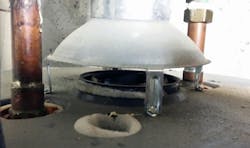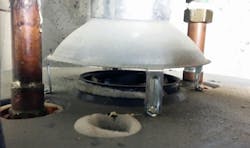Last month, I attended three combustion related sessions at the 5th Annual HVAC School Symposium. Rachel Kaiser with WiseRAT LLC, Tyler Nelson with the Sauermann Group, and Tony Gonzales with Fieldpiece all presented on the importance of proper combustion testing.
These sessions encouraged me because I’ve been outspoken about the importance of combustion safety for more than two decades. Our industry is finally showing movement in the right direction. However, we still have a lot of work to do.
Unfortunately, there are still HVAC companies who leave combustion testing out of their service offerings. They just don’t understand its importance. Instead, they rationalize there are no problems because they follow traditional methods. Here are four of the ways we justify avoiding combustion testing. See if they sound familiar.
The Customer Has a Store-Bought CO Alarm
“All buildings should have a carbon monoxide (CO) alarm.” This is the prevailing wisdom we hear from many industry experts. We rationalize if a combustion problem appears, the CO alarm sounds and alerts everyone of potential danger. We don’t have to worry about anything because the alarm will do its job.
So, how well does a CO alarm do its job?
Our industry has a professional responsibility to serve and protect its customers. I’m afraid we take this obligation too lightly.
Standard UL 2034 rates and certifies store-bought CO alarms. You can look at the alarm or read the instruction manual to find the CO level and exposure length that sets off the alarm. Typically, these are:
- 70 PPM ± 5 PPM for 60 to 240 minutes
- 150 PPM ± 5 PPM for 10 to 50 minutes
- 400 PPM ± 10 PPM for 4 to 15 minutes
Many store-bought alarms fail to sound at these levels:
- 30 PPM ± 3 PPM for 30 days
- 70 PPM ± 5 PPM for 60 minutes.
You may believe these devices are more than sufficient to protect your customers. What about the other warning label on most CO alarms that say it might not be sensitive enough for the young, elderly, or individuals with health problems? How well does the CO alarm do its job then? The answer is, they don’t for low-level CO protection.
There’s a Venting System
Another way we rationalize not combustion testing is that most fuel-fired equipment has a venting system to exhaust combustion gases outdoors. If you find steam leaving the vent cap, the flue gases are leaving the equipment. Sounds good, right?
What about those situations where you can’t see steam exhausting? You could hold a match or use smoke around the base of the drafthood. If air pulls into the hood, everything works as designed, right? A plugged heat exchanger wouldn’t affect this interaction, would it?
What about unvented appliances like a gas oven or fireplace? Should a homeowner worry about them? Some of these units have been around for decades with no vent. After all, if they were unsafe, production would have stopped long ago, right? However, if something unfortunate happened, the store-bought CO alarm would catch the problem, wouldn’t it? I have my doubts.
The Flame is Blue
Another way we try to avoid combustion testing is with a technique known as “eyeballing” the flame. We believe if the flame is blue, it is safe and clean burning. However, if the flame has yellow tips or burns yellow, it is an incomplete burn that produces CO. While this sounds good, and we often repeat it, is it the truth?
Early in my career, I watched a technician I was working with get hit with a fireball from flame rollout on an old, natural draft furnace. It didn’t take long to figure out that watching the flame, especially when ignition occurs, is a bad idea. How has eyeballing the flame become so popular when it obviously puts a technician at risk? Isn’t there a safer way?
Rachel Kaiser did an interesting experiment during her HVAC Symposium session this year. She injected various chemicals into a flame to see how they would affect the color. The color spectrum changed from blue to pink to green, with shades in between, depending on the chemical introduced into the flame. So, which color was the right color? There simply isn’t enough information to know.
No Cracks in the Heat Exchanger
Our industry focuses a lot on cracked heat exchangers as a CO source. We rationalize that if there’s a crack in the heat exchanger, CO leaks into the airstream and moves through the duct system, into the building. Common knowledge, right? But doesn’t the highest area of positive pressure in an HVAC system surround the heat exchanger?
A heat exchanger inspection is one of the first checklist items on many maintenance and service calls. If the heat exchanger is “leak-free” then all should be good and there’s no need for further safety tests. You eliminated every potential CO suspect with this single inspection, right? No crack, no problems?
However, many technicians frequently find cracked heat exchangers. When they do, they make the needed repairs or turn off the furnace. Once you find a cracked heat exchanger, you find the CO source, right? You fix it and move on to the next job. Problem solved. Surely it won’t fail again. Or will it? Unless you measure, you’ll never know.
Surely You Can’t Be Serious?
Unfortunately, our industry makes the above rationalizations too many times. I didn’t name all of them. There’s more. I’m ashamed to say that I know them because I used them all when I didn’t know any better. However, once I learned there was more to combustion, I had an obligation to improve. The questions above should make this painfully obvious.
Our industry has a professional responsibility to serve and protect its customers. I’m afraid we take this obligation too lightly. When you look at it from this angle, it seems ridiculous not to test combustion. Unfortunately, there are companies right now working on fuel-fired equipment using antiquated assumptions to assure safe equipment operation.
My world changed after I committed myself to testing because testing showed me the truth. What if you made that same commitment? What if you measure and discover CO that a store-bought alarm didn’t pick up? Would the change be worth it? Why not commit to doing the right thing and make combustion testing part of your business? If you stick with it for more than a month, I believe you will discover you made the right decision.
David Richardson serves the HVAC industry as Vice President of Training for the National Comfort Institute, Inc. (NCI). NCI specializes in training that focuses on improving, measuring, and verifying HVAC and Building Performance.
If you’re an HVAC contractor or technician interested in learning more about how to start combustion testing, contact David at ncilink.com/ContactMe. NCI’s website www.nationalcomfortinstitute.com is full of free information to help you improve your professionalism and strengthen your company.
About the Author
David Richardson
Director, technical curriculum
David Richardson serves the HVAC industry as director of technical curriculum at National Comfort Institute, Inc. (NCI), Avon, Ohio. NCI specializes in training that focuses on improving, measuring, and verifying HVAC and Building Performance.

